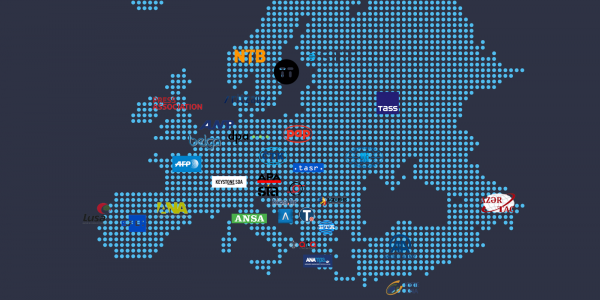The Future of National News Agencies in Europe: Yle’s Atte Jääskeläinen on the Challenges and Opportunities Ahead

If you work in, or indeed, know anything at all about the news industry, you’ll know that things are changing faster than ever before. As digital overtakes print, AI technology advances and newsroom automation fulfils tasks that a journalist was once required for, news organisations must find ever-more innovative ways to adapt to a shifting landscape.
It’s an issue that’s been tackled to death in op-eds, discussed in meetings and talked over at length in conference rooms around the world. Atte Jääskeläinen, former director of news and current affairs at Finnish broadcasting company Yle, however, believes that thorough academic research on the subject is still curiously lacking. That’s why he’s partnered with the European Alliance of News Agencies to carry out an extensive research project at the London School of Economics (LSE) titled: ‘The Future of National News Agencies in Europe.’
Sourcefabric recently caught up with Atte to check in on what he’s learned so far, what he aims to achieve and how news agencies might look to innovate for the future.
Firstly, could you please tell us a little bit about the project? What are the general aims of your research?
The business or operational logics of national news agencies are not very well known and there is very little academic research on them. We’re trying to map the industry in Europe and also better highlight some strategies for their future development issues. We want to collaborate with the industry and have a real impact on both them and policymakers.
And as someone who's gained years of experience in editorial positions, what were you seeing or experiencing in these professional roles that motivated you to take this project on?
News agencies are in key positions in the changing national news markets: All the biggest challenges and opportunities can be seen there. For news agencies to be successful it’s crucial to understand not only the needs of their media clients, but also the needs and behaviours of their clients, that is, the end-users of news.
This builds up a picture that covers 360 degrees of media in a very interesting way, and if you multiply that by 25 different countries, you start to understand why it is both exciting and educational to study how the national news agencies in Europe are doing and what might be the secret sauce for the successful ones.
Those who work in the news industry are well aware that lots of change has taken place in recent history. How would you describe these changes in the newsroom, and how do you think news agencies are coping?
I would say the changes have been dramatic. The whole news industry is experiencing a revolution. Some of the agencies are coping quite well, but most of them are one way or another struggling because their main clientele, meaning newspapers, are suffering. A news agency can't be a successful business if its customers are not able to pay the fees.
Atte Jääskeläinen
To return to your own career; while you were working at Yle in Finland, two news organisations came together to work as an integrated, multi-platform news organisation. Could you tell me a little about this and whether it was successful? If so, do you believe that collaboration will be a significant factor in the future sustainability of news agencies?
Yes, we merged first radio and television newsrooms to an integrated newsroom, but later focused also on innovating new services, personalisation and experiments in social media experiments.
It could be described as a success; in the latest Reuters Institute Digital News Report (2018) Yle News, a brand that did not exist before 2007, was the most trusted news brand of all 37 national markets. Yle's online news offering placed at third for the most important news source for Finns, and was considered by 60% of the population as the leading newsroom of the country. All quality attributes had improved significantly, and even the audience of its main television news programme had grown.
In today’s media environment you have to have a certain scale to be able to develop new services and invest in IT. Collaboration is a good way of achieving that.
One key element in building cost-effective business models for news agencies is the IT side of operations. What is your opinion on the use of open source tools or open source newsroom software to promote sustainable business models for news agencies?
Open source in an important and cost-effective part of the portfolio of tools to react quickly to changing environments. Open source arrangements are also a good way to collaborate internationally to create systems if several players share same interests. Cost-effectiveness plays an extremely important central role in value creation in news agencies, but technology can create value as well. Artificial intelligence and robotics combined with personalisation can be something news agencies could provide to their clients as a service.
And finally, with increasing numbers of people gathering their news from informal sources like social media, do you believe news agencies have a chance of surviving long into the future?
Yes, I do. However, like all media organisations nowadays, they have to be extremely innovative and able to adapt to a changing environment and to look for different kinds of new funding sources. Commercially operating news agencies will certainly have difficulties if their main revenue stream is based only on classical wire service offered to printed newspapers.
